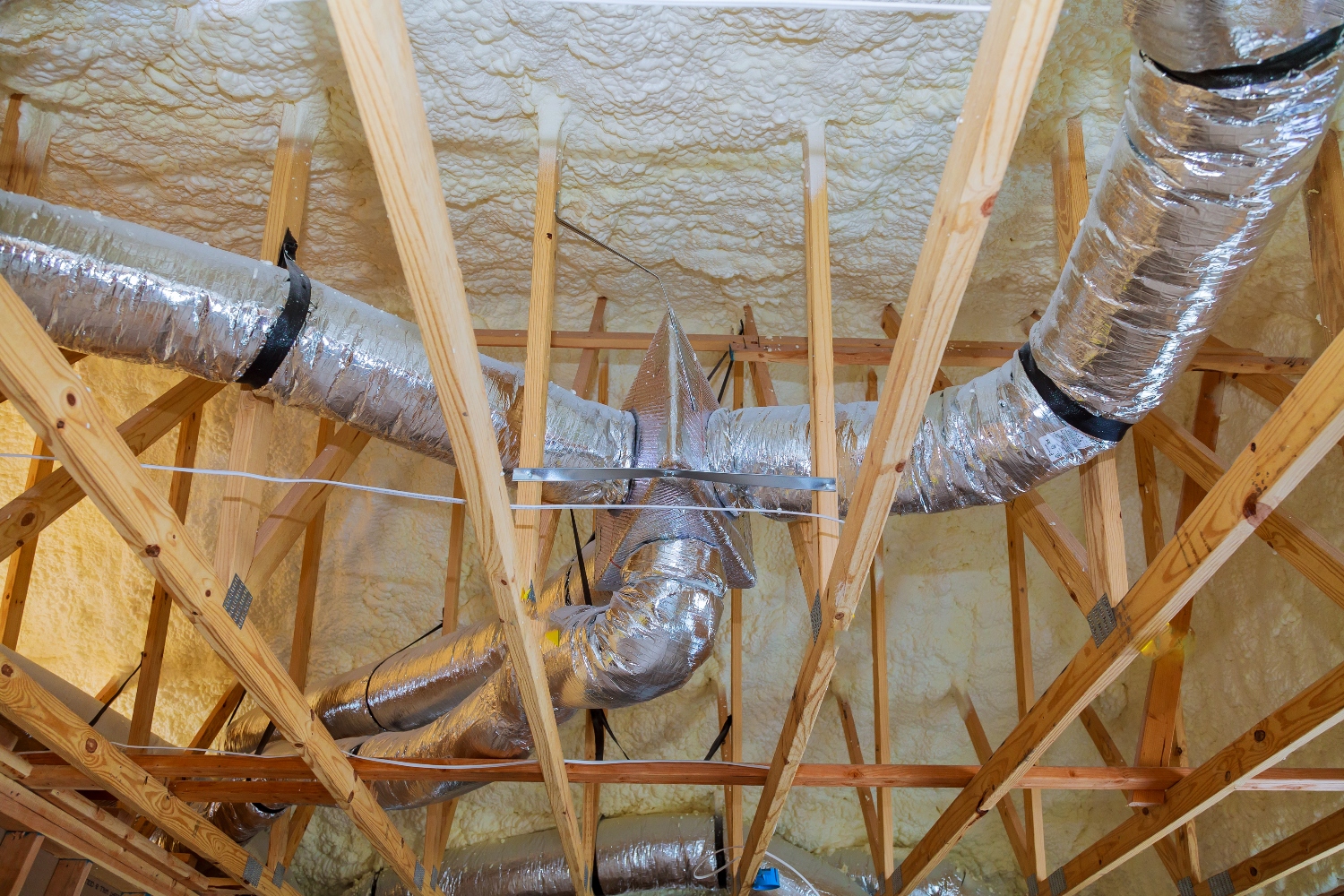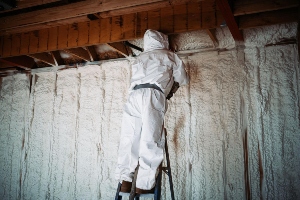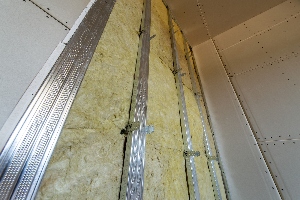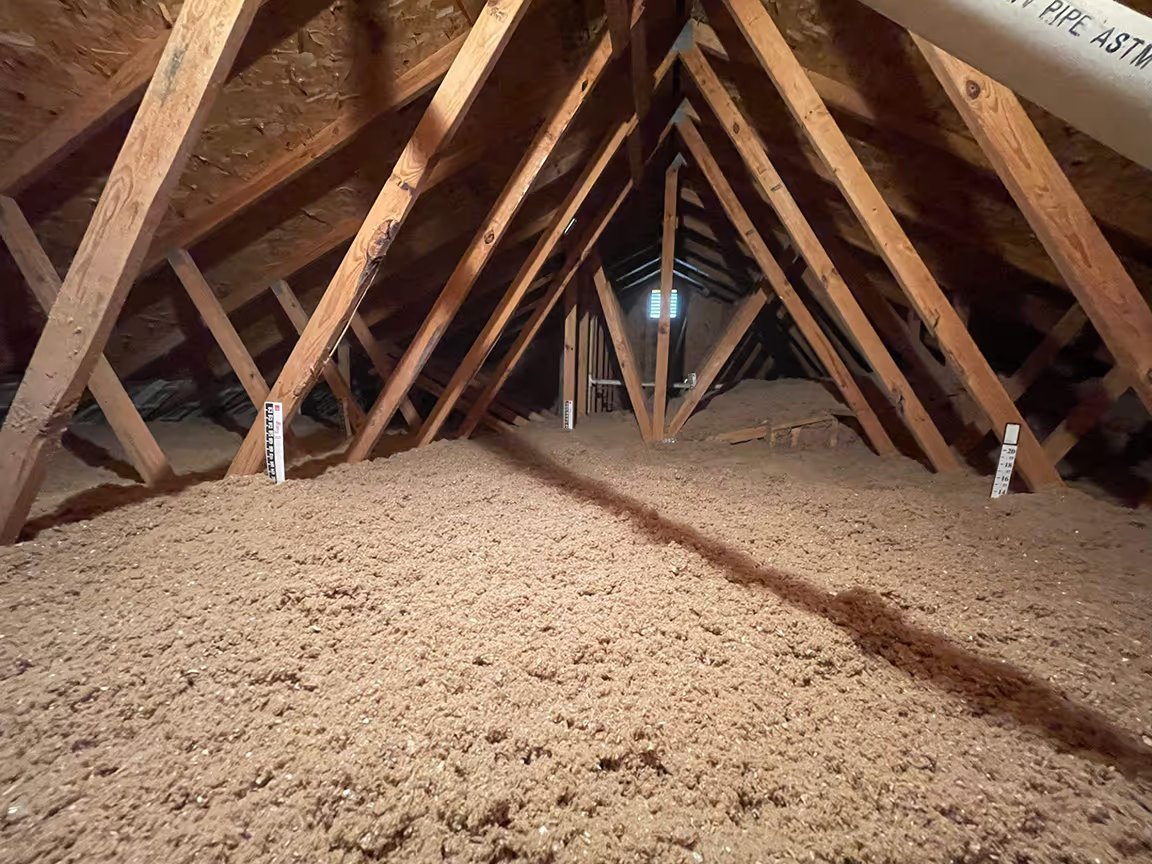Many homeowners wonder: do I need insulation if I have HVAC? The answer is yes! Insulation and HVAC systems work together as partners, not replacements for each other. Even the most advanced HVAC system will struggle to keep your home comfortable and energy bills reasonable without proper insulation.
Research from the North American Insulation Manufacturers Association shows that about 90% of American homes are under-insulated. This means most of us are making our heating and cooling systems work harder than necessary. Insulation forms the thermal barrier of your home, keeping heat out during summer and in during winter.
We often find that homeowners focus on upgrading their HVAC equipment while neglecting insulation. This is a costly mistake. Without good insulation, your new system will waste energy trying to heat or cool a home that can't maintain temperature properly. Think of it this way - insulation is like a thermos that helps your HVAC system's efforts last longer.
This guide explains how insulation and HVAC efficiency go hand in hand and why addressing both is key to an energy-efficient home through the below topics:
- How insulation and hvac work together
- Signs your home relies too much on hvac (and not enough on insulation)
- Why insulation should come before (or with) your hvac upgrade
- Rebates and energy programs that may require both
- How to assess your home's insulation needs
Keep reading!
How insulation and hvac work together
Your home's comfort and energy efficiency depend on how well these two systems work as partners. Insulation creates a protective barrier while HVAC manages temperature and air quality.
HVAC treats the air, insulation keeps it inside
HVAC systems are responsible for heating, cooling, and ventilating your home. They work to treat the air to your desired temperature and quality. However, this treated air needs to stay inside to be effective.
That's where insulation comes in. Insulation creates a thermal barrier in your building envelope that prevents the transfer of heat. In winter, it keeps warm air from escaping. In summer, it blocks hot air from entering.
Without proper insulation, your carefully conditioned air simply leaks outside. Think of insulation as a thermal container that holds the work your HVAC system performs.
The relationship is straightforward: your HVAC creates comfortable air, and insulation makes sure it stays where it should.
Why poor insulation makes even the best hvac inefficient
Even the most advanced HVAC system will struggle in a poorly insulated home. When insulation is inadequate, your system must work harder and run longer to maintain comfortable temperatures.
This leads to several problems:
- Higher energy bills as your system runs constantly
- Increased wear and tear on HVAC components
- Shorter equipment lifespan due to overuse
- Uncomfortable temperature variations throughout your home
Air leaks in your building envelope force your system to compensate for constantly escaping thermal energy. It's like trying to heat or cool your home with windows open.
We often see homeowners replace their HVAC systems hoping to fix comfort issues, when better insulation would have solved the problem at lower cost.
Common myths about heating and cooling systems
Myth 1: A powerful HVAC system eliminates the need for good insulation. Reality: Stronger systems without proper insulation just waste more energy and money.
Myth 2: Insulation is only important in cold climates. Reality: Insulation is crucial in all climates, as it keeps cool air in during summer months too.
Myth 3: Duct insulation doesn't matter if the home is well-insulated. Reality: Uninsulated ducts can lose 25-40% of heating or cooling energy as air travels through them.
Myth 4: New homes don't need insulation upgrades. Reality: Even new construction often has minimum-required insulation levels that can be improved for better efficiency.
Understanding these connections helps homeowners make smarter decisions about home comfort improvements.
Signs your home relies too much on hvac (and not enough on insulation)
Even the most advanced HVAC system can't overcome the problems of poor insulation. Many homeowners overlook this critical relationship, forcing their heating and cooling systems to work harder than necessary.
High energy bills despite new hvac equipment
High energy costs often signal that your home lacks proper insulation. If you've recently upgraded your HVAC system but haven't seen a decrease in your utility bills, insulation is likely the culprit.
Modern HVAC units are designed to be energy-efficient, but they can't perform optimally in a poorly insulated home. The system has to work continuously to maintain comfortable temperatures when heated or cooled air escapes through walls, attics, and crawlspaces.
Take a look at your energy bills over several seasons. Are they consistently higher than neighbors with similar-sized homes? This could indicate your HVAC system is compensating for heat loss or gain that proper insulation would prevent.
Consider an energy audit to identify specific areas where insulation improvements would have the biggest impact on your bills.
Uneven temperatures between rooms or floors
Walking from a comfortable living room into a freezing bedroom is a clear sign of insulation problems. Temperature fluctuations between rooms shouldn't exist with a properly insulated home.
Upper floors often feel warmer than lower levels because heat rises. But extreme differences suggest insufficient insulation in exterior walls, around windows, or in attic spaces.
Temperature zoning issues persist despite advanced HVAC settings when insulation is inadequate. You might notice:
- Rooms facing different directions feel dramatically different
- Upstairs areas that are always too hot in summer
- Basement or first-floor rooms that never warm up in winter
These inconsistencies force your HVAC system to run longer cycles trying to balance temperatures throughout your home.
Constant cycling of ac or furnace
When your HVAC equipment turns on and off frequently throughout the day, it's working harder than necessary. This "short cycling" often happens because poor insulation allows conditioned air to escape quickly.
Your system might reach the thermostat's target temperature momentarily, but then shuts off, only to restart minutes later when the temperature drifts again. This pattern is inefficient and shortens the lifespan of expensive HVAC components.
Listen for how often your system kicks on. In a well-insulated home, heating and cooling cycles should be relatively long with decent rest periods in between.
Short cycling not only drives up energy costs but also prevents proper humidity control and air filtration. The constant starting and stopping puts unnecessary strain on your system's motors and compressors.
Cold drafts or hot walls even with hvac running
Feeling air movement near windows or exterior doors while your HVAC runs indicates insulation problems. Drafts mean outside air is infiltrating your home despite your heating or cooling efforts.
Touch your interior walls on extremely hot or cold days. They should feel neutral, not hot or cold. Exterior-facing walls that reflect outside temperatures need better insulation inside the wall cavities.
Other signs include:
- Cold floors in winter
- Hot ceilings in summer
- Noticeable temperature changes when walking past windows
- Rooms that feel stuffy or take longer to heat/cool
These issues force your HVAC system to compensate for constant temperature intrusions. Proper insulation creates a thermal barrier that maintains your home's internal climate regardless of outdoor conditions.
Why insulation should come before (or with) your hvac upgrade
Proper insulation is the foundation of home comfort and energy efficiency. Upgrading insulation before installing a new HVAC system can save you thousands of dollars and create a more comfortable living environment.
Lower system load = smaller, cheaper hvac unit
When your home is well-insulated, your HVAC system doesn't need to work as hard to maintain comfortable temperatures. This directly impacts the size of system you'll need. With better insulation, you might qualify for a smaller unit that costs less upfront.
Many homeowners make the mistake of buying oversized HVAC systems to compensate for poor insulation. This leads to higher purchase costs and inefficient operation. Before selecting a new system, have a professional conduct a Manual J load calculation after insulation improvements.
The right-sized system for a well-insulated home can cost $1,000-3,000 less than an oversized unit. Plus, utility companies often offer rebates for insulation upgrades that can offset 10-30% of your investment.
Extends the life of your hvac system
Insulation creates a protective barrier that reduces the workload on your heating and cooling equipment. Without proper insulation, HVAC systems cycle on and off frequently, causing unnecessary wear and tear.
These frequent cycles are like constantly starting and stopping your car—it burns more fuel and wears out components faster. In well-insulated homes, systems run in longer, more efficient cycles.
This reduced strain can extend your HVAC system's lifespan by 3-5 years. Considering that a new system typically costs $5,000-10,000, those extra years of service represent significant savings.
Regular maintenance combined with good insulation creates the ideal environment for your HVAC system to operate efficiently for years to come.
Better comfort with less energy
Insulation creates consistent temperatures throughout your home by minimizing air leakage and thermal transfer. Without it, even the most powerful HVAC system will struggle to maintain comfort.
Well-insulated homes have fewer drafts, cold spots, and temperature fluctuations. This means every room stays comfortable without constantly adjusting the thermostat.
The energy savings are substantial—proper insulation can reduce heating and cooling costs by 15-30%. For the average household spending $2,000 annually on energy, that's $300-600 in savings each year.
The comfort improvement is immediate and noticeable. You'll feel the difference in how quickly your home reaches the desired temperature and how well it maintains it, even during extreme weather.
Rebates and energy programs that may require both
Many energy efficiency programs reward homeowners who take a comprehensive approach to home improvement. These programs often require both proper insulation and efficient HVAC systems working together.
The Energy Efficient Home Improvement Credit (25C) allows homeowners to claim tax credits for qualified energy improvements. When calculating your credit, you'll need to subtract any rebates or incentives you've already received, as these are considered purchase price adjustments.
Many utility companies offer subsidies specifically for homes that implement multiple energy-saving measures. These incentives often increase when you combine insulation upgrades with HVAC improvements.
Important tip: It's smart to spread improvements over several years to maximize tax benefits. The annual aggregate limits on tax credits make this strategy financially advantageous.
Before making any improvements, we recommend getting a professional home energy audit. These assessments identify the most effective upgrades for your specific home and may be available at reduced costs through local programs.
The Inflation Reduction Act provides significant rebates for homeowners who install heat pumps while also improving insulation. Combined rebates can reach up to $3,200 for complete system replacements.
When planning energy upgrades, look for state and local government programs that can be combined with federal tax credits. This layering of benefits can substantially reduce your out-of-pocket costs.
How to assess your home's insulation needs
Evaluating your home's insulation is crucial for maximizing HVAC efficiency. Proper assessment can identify gaps that waste energy and strain your heating and cooling systems.
Areas most commonly under-insulated
Attics are typically the biggest culprits for heat loss. Many homes have insufficient attic insulation, falling below the recommended R-value of 38-60 depending on your climate zone. This causes your HVAC system to work overtime.
Exterior walls often lack adequate insulation, especially in older homes. Signs include cold wall surfaces in winter or walls that feel hot during summer months. The recommended R-value for walls ranges between 13 and 19.
Basements and crawlspaces are frequently overlooked. These areas should have R-values of at least 15 for basement walls and 30 for crawlspaces. Poor insulation here affects your entire home's temperature regulation.
Ductwork running through unconditioned spaces loses significant heating and cooling when not properly insulated. This directly impacts HVAC performance and energy bills.
What to expect during an insulation inspection
A professional insulation inspection starts with a comprehensive home energy audit. This gives you a clear picture of your home's overall energy performance.
Thermal imaging cameras detect hidden issues that visual inspections might miss. These cameras reveal temperature variations that indicate insulation gaps or failures.
Inspectors will check insulation depth and condition in accessible areas like attics. They'll look for settlement, moisture damage, and signs of pest infestation.
Wall insulation assessment might involve small inspection holes or special tools to determine what's inside wall cavities without major disruption.
The inspection should include a blower door test to measure air leakage rates. This test identifies where outside air infiltrates your home, compromising insulation effectiveness.
How terra insulation builds a home energy strategy
At Terra Insulation, we develop customized solutions based on your home's specific needs. Our approach considers your local climate, existing HVAC system, and typical energy usage patterns.
We prioritize the highest-impact areas first. This usually means focusing on attic insulation and air sealing before moving to walls and floors for the best return on investment.
The EPA estimates that homeowners can save an average of 15% on heating and cooling costs by combining air sealing and insulation in key areas of the home, demonstrating how insulation directly amplifies HVAC efficiency
Our recommendations include specific insulation types and R-values matched to each area of your home. This ensures you get the right protection without overspending.
We provide clear cost-benefit analysis for each recommended improvement. This helps you understand potential energy savings versus installation costs.
Our strategies often combine insulation with complementary improvements like weatherstripping and duct sealing. This comprehensive approach maximizes HVAC efficiency and comfort throughout your home.
Conclusion
Insulation and HVAC systems work together to create an efficient, comfortable home. They are not replacements for each other but complementary components of your home's climate control system.
Even with the best HVAC system, proper insulation is essential. It helps maintain consistent temperatures, reduces energy costs, and extends the life of your HVAC equipment.
The right insulation, with appropriate R-values for your climate zone, can cut your heating and cooling needs by up to 30%. This translates to significant savings on your utility bills and a smaller carbon footprint.
We recommend consulting with professionals to assess your home's specific insulation needs. They can identify problem areas and recommend improvements that work with your existing HVAC system.
Remember that insulation is a long-term investment in your home's efficiency and comfort. While upgrading your HVAC system might improve performance, it can't compensate for poor insulation.
For optimal results, prioritize both proper insulation and an efficient HVAC system. This combination provides the best indoor comfort while minimizing energy use and costs.
To maximize your system’s efficiency, schedule a home energy assessment with Terra Insulation. Our experts will identify insulation gaps and help you create a strategy that aligns with your HVAC system for optimal performance and comfort.






